Archive for 2012
Monday, December 24th, 2012
The Texas Department of Licensing and Regulation regulates the Architectural Barrier Act and the Texas Accessibility Standards in Texas. They also issue memos that explain certain ambiguous terms and concepts in the Standards. They have issued four so far to explain the 2012 TAS. This newsletter explain them.
TM 2012-01 Electrical Vehical Charging Station
The Technical Memorandum TM 2012-01 has requirements for Electrical Vehicle Charging Station.
Because the US Department of Justice have not issued guidelines for Electric Vehicle Charging station, TDLR decided to create one. So in Texas this is the requirements:
Twenty percent (20%) but not less than one, of each type of charging station in each cluster on a site shall meet the following criteria:
- Controls and operating mechanisms for the accessible charging station shall comply with TAS 309 (no twisting of the wrist and less than 5 lbs to operate) and shall be within the forward reach ranges specified in TAS 308.2;
- The vehicle space(s) with the accessible charging station shall be at least 96 inches wide and shall provide a 36 inch wide (minimum) accessible route complying with TAS 402 on both sides of the vehicle space to allow the user adequate space to exit their vehicle and access both sides of the vehicle. Striping of the accessible routes is recommended but not required.
- Directional and informational signage complying with TAS 216.3 shall designate the location of the accessible charging stations. The symbol of accessibility is recommended but not required.
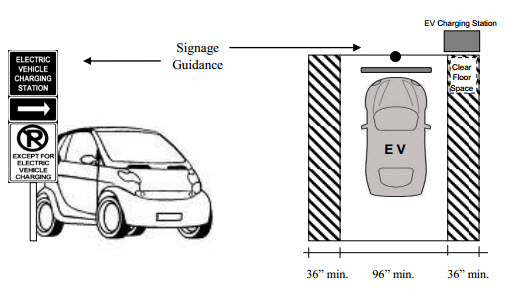
This figure is just one example. There might be other ways to meet the requirements
TM 2012-02 Emergency Response Building and Facilities
The Technical Memorandum TM 2012-02 explains what to do with facilities for emergency response personnel. This was taken from the US Access Board and DOJ Commentary. There are basically Three type of areas within emergency response facilities:
- Crew quarters that are used exclusively as a residence by emergency response personnel and the kitchens and bathrooms exclusively serving those quarters shall comply with the requirements of 233 (including 233.3.1) and 809 for residential facilities and residential dwelling units.

- All other common use areas, elements, and spaces, including, but not limited to, parking, drinking fountains, public restrooms, meeting and training rooms, and conference rooms, shall comply with the 2012 TAS. Multi-story buildings and facilities shall comply with the accessible route requirements found in 206.2.3 unless exempted by 206.2.3, Exception 2, which states that in a public building that is less than three stories with less than 5 occupants on the upper or lower story, an accessible route is not required.
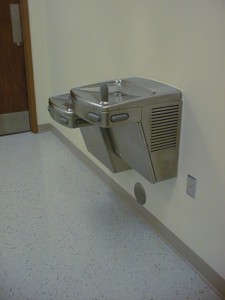
- Truck bays, workshops, and other employee work areas, elements, and spaces used exclusively by emergency personnel for work shall comply with 203.9 and other provisions of the 2012 TAS applicable to employee work areas which state only approach, enter and exit is required.

TM 2012-03 Shopping Centers and Shopping Malls
The Technical Memorandum TM 2012-03 explains what defines a shopping center or shopping mall and how this affects the elevator/accessible route exception.
The definition of a shopping center is:
a) A building housing five or more sales or rental establishments; or
b) A series of buildings on a common site, either under common ownership or common control or developed either as one project or as a series of related projects, housing five or more sales or rental establishments
If a private building is a shopping center and has more than one story, an accessible route is required, no matter what is going on on the second story.
But there is an exception if it is a retail space in a one story building with a mezzanine.
A free standing store, like Walmart is not a shopping center and therefore a mezzanine may not require an accessible route if it meets all the criteria on 206.2.3 Exception 1 or 206.2.4 Exception 3.
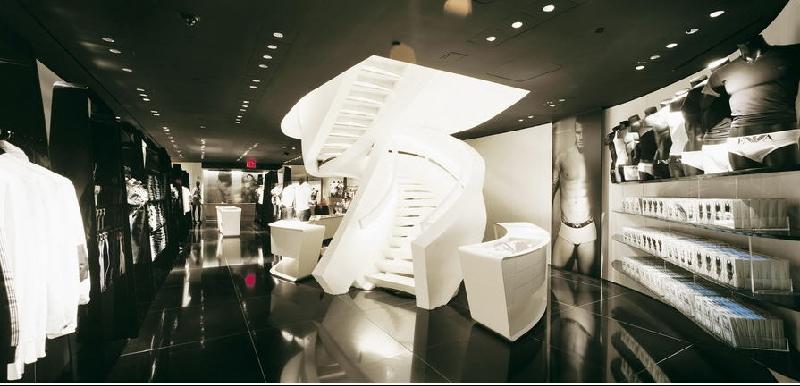
This photo is of a retail story with a second story and it does require an accessible route to the second story.
TM 2012-04 Multi-Story Buildings and Facilities
The Technical Memorandum TM 2012-04 explains what is meant by “square feet” and “per story” in 206.2.3, Exception 1:
- Square Feet. The reference to “square feet” shall mean gross square feet.
- Per Story. The term “story” is defined in 106.5.64 as that portion of a building or facility designed for human occupancy included between the upper surface of a floor or the upper surface of the floor or roof next above. A story containing one or more mezzanines has more than one floor level.
Therefore, based on 106.1 and the indicated meaning of “story”, the reference to “per story” shall also apply to the first story when calculating square footage.
These clarifications have been confirmed by the Department with the U. S. Access Board and do not constitute a substantive change to the compliance requirements of 206.2.3, Exception 1.
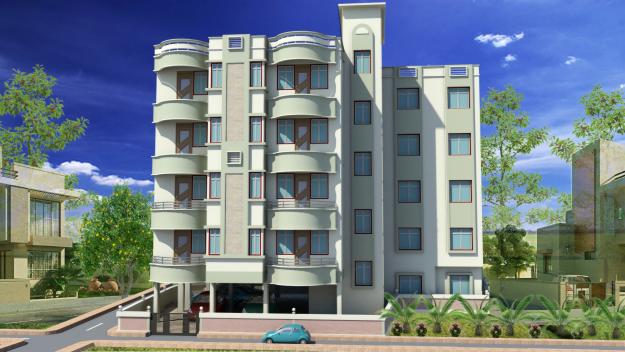
Continuing Education Opportunities
New Orleans
4 hr HSW: 2010 ADA and IBC
Please use this link below for registration and details
Little Rock
4 hr HSW 2010 ADA and IBC
Please use this link below for registration and details
If you want to learn more about the new Standards, The ADA Companion Guide explains the 2004 ADAAG Guidelines with commentary and explanations throughout. The 2004 Guidelines were adopted by the DOJ to create the 2010 Standards and by Texas to create the 2012 TAS. This book explains the technical requirements for both.
If you have any questions about these or any other topics, please feel free to contact me anytime.
Marcela Abadi Rhoads, RAS #240
Abadi Accessibility
214. 403.8714
Tuesday, November 27th, 2012
There are four new technical Memorandum for the 2012 TAS. These are explanations that the Texas Department of Licensing and Regulation issue in order to explain ambigous guidelines.
1. TM 2012-01 Electric Vehicle Charging Station
2. TM 2012-02 Emergency Response Building and Facilities
3. TM 2012-03 Shopping Center and Shopping Malls
4. TM 2012-04 Multi-Story Buildings and Facilities
For more information about these, stay tuned for my newsletter December 1st.
Saturday, November 24th, 2012
There are just 5 days before we all get out and vote for President of the United States. Voting is a right that is protected for everyone who is eligible, including the disabled community. Polling places must be accessible. Even though they are temporary places, they are still a voting place and will require some form of access. The voter who is disabled must be able to have the same privacy as everyone else. The voter who is disabled must have access to the same ballot and the same method of voting as everyone else. So how does a polling place provide this access? The ADA website has a pamphlet that they put out in 2004 that explains how to provide access even when the polling place is only temporary. The Election Assistance Commission has a video that is also helpful for polling places to provide access. Below is a summary
Polling Places Accessibility requirements
A. Accessible parking or passenger drop off should be available
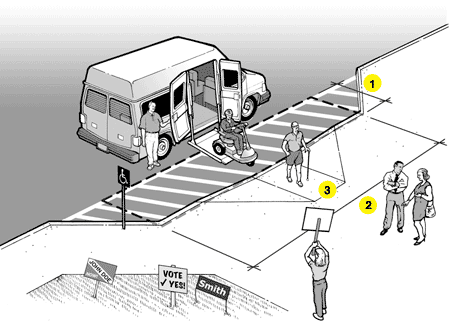
Passenger Drop Off
- Access aisle depth is at least 5′-0″
- Access aisle lenght is at least 20 feet
- Curb ramp connects access aisle to the accessible route to the accessible entrance of the polling places.
Parking

- Marked access aisle
- no more than 2% slope for both parking and access aisle
- Parking sign
- Accessible route from parking up to the entrance of the polling place
B. An Accessible route to the entrance
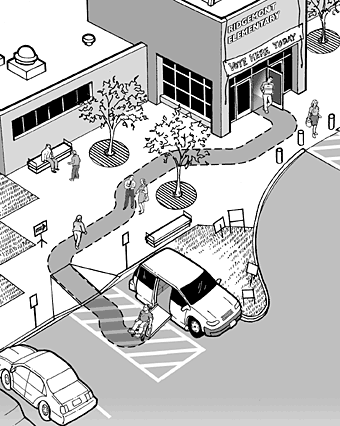
Route must be unobstructed
C. An accessible entrance to the voting site (It can be a temporary ramp)

Ramp
- At least 36″ between handrails
- Top landing part of the walk
- Bottom landing part of walk
- Handrails height 34″ to 38″
- Edge Protection
D. A route free from hazards
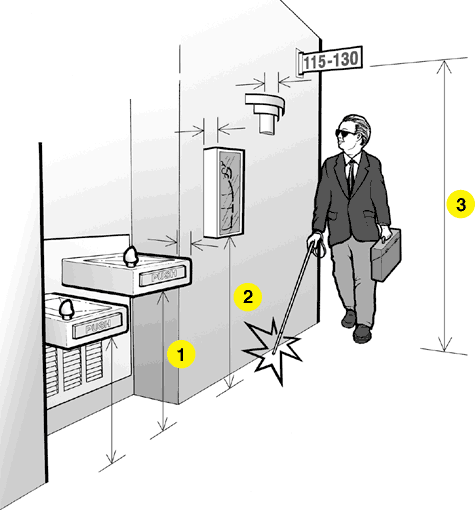
- Wall mounted drinking fountains are a hazard when the front projects more than 4″ beyond the wall and the bottom is more than 47″ above the floor
- Wall mounted objects cannot project more than 4 inches beyond the wall if the bottom is not in the cane-detectable area below 27 inches off the floor
- Overhead objects must be at least 80 inches off the floor
E. A route to the voting booth and to all the common spaces within the facility
- Accessible route connects building entrance with the voting area, including voter check in and accessible voting machine
- Accessible route connects the accessible entrance with voting areas
- Accessible door and doorway to voting area,
Note: A turning space should also be provided. If there are deaf voters who need assistance, the blinds should be closed behind the check-in so voters who read lips can communicate with the voting staff.
F. Temporary Solutions for Election Day
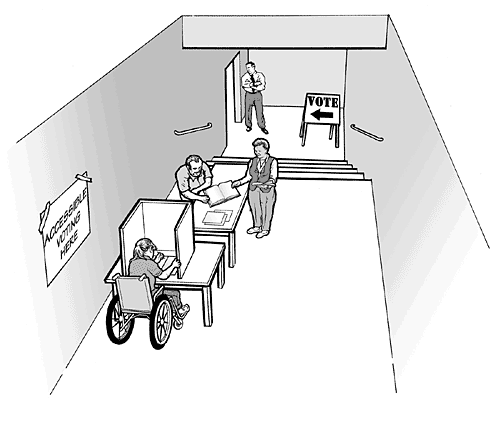
If a polling area is not accessible, find an accessible space near the voting area. Counter or table where the voting is taking place should be between 28 in to 34 inches in height and a forward approach knee space should be provided
Everyone should go to their polling places and make sure there are facilities that are accessible for voters in wheelchairs, voters who are visually impaired as well as hearing impaired. Let’s try and make this election an accessible one.
Continuing Education Opportunities
November 2- International Facilities Managers Association Convention in San Antonio, Texas
November 7- provided by SSTL Codes 4 hr ADA seminar in Tulsa OK
If you want to learn more about the new Standards, The ADA Companion Guide explains the 2004 ADAAG Guidelines with commentary and explanations throughout. The 2004 Guidelines were adopted by the DOJ to create the 2010 Standards and by Texas to create the 2012 TAS. This book explains the technical requirements for both.
If you have any questions about these or any other topics, please feel free to contact me anytime.
Marcela Abadi Rhoads, RAS #240
Abadi Accessibility
214. 403.8714
Tuesday, October 23rd, 2012
In the 2010 ADA and the 2012 TAS there are certain elements that require front approach and parallel approach. But not all of those also require for them to be centered along the element. This newsletter will enumerate the one’s that do. Other elements such as lavatories and sinks and operating mechanisms only require forward approach but it is not required to be centered.
Centered Elements
602 Drinking Fountain
602.2 Clear Floor Space. Units shall have a clear floor or ground space complying with 305 positioned for a forward approach and centered on the unit. Knee and toe clearance complying with 306 shall be provided.
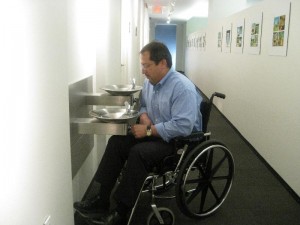
611 Washer and Dryer
611.2 Clear Floor Space. A clear floor or ground space complying with 305 positioned for parallel approach shall be provided. The clear floor or ground space shall be centered on the appliance.
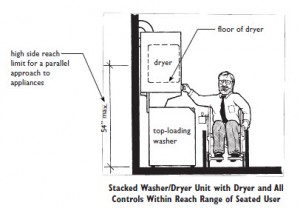
703 Signage
703.4.2 Location. Where a tactile sign is provided at a door, the sign shall be located alongside the door at the latch side. Where a tactile sign is provided at double doors with one active leaf, the sign shall be located on the inactive leaf. Where a tactile sign is provided at double doors with two active leafs, the sign shall be located to the right of the right hand door. Where there is no wall space at the latch side of a single door or at the right side of double doors, signs shall be located on the nearest adjacent wall. Signs containing tactile characters shall be located so that a clear floor space of 18 inches (455 mm) minimum by 18 inches (455 mm) minimum, centered on the tactile characters, is provided beyond the arc of any door swing between the closed position and 45 degree open position.
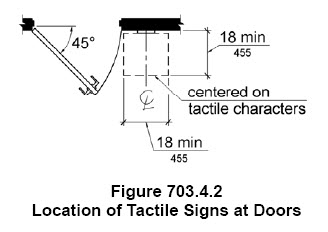
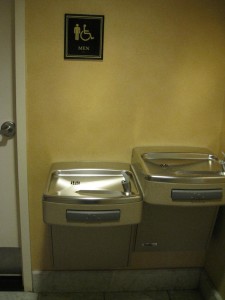
This sign has a drinking fountain in front of it, therefore the requirement for a clear floor space centered on the sign has not been met.
804.3 Kitchen Work Surface (Residential only)
804.3.1 Clear Floor or Ground Space. A clear floor space complying with 305 positioned for a forward approach shall be provided. The clear floor or ground space shall be centered on the kitchen work surface and shall provide knee and toe clearance complying with 306.
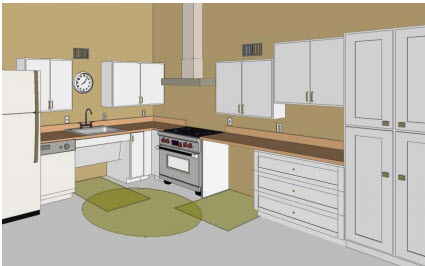
904.4 Sales and Service Counters.
EXCEPTION: In alterations, when the provision of a counter complying with 904.4 would result in a reduction of the number of existing counters at work stations or a reduction of the number of existing mail boxes, the counter shall be permitted to have a portion which is 24 inches (610 mm) long minimum complying with 904.4.1 provided that the required clear floor or ground space is centered on the accessible length of the counter.
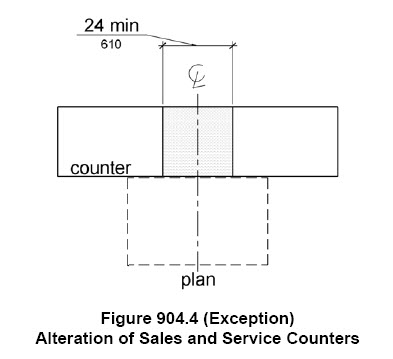
Playground Transfer Systems
1008.3.1.3 Transfer Space. A transfer space complying with 305.2 and 305.3 shall be provided adjacent to the transfer platform. The 48 inch (1220 mm) long minimum dimension of the transfer space shall be centered on and parallel to the 24 inch (610 mm) long minimum side of the transfer platform. The side of the transfer platform serving the transfer space shall be unobstructed.
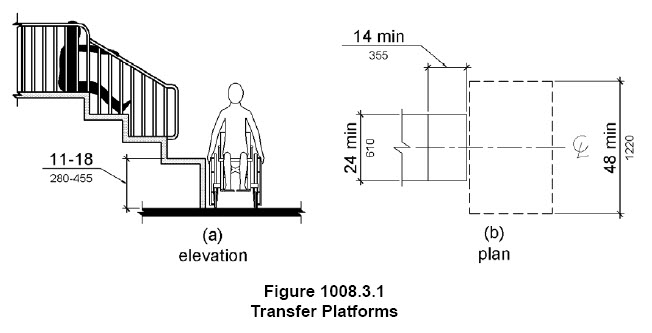
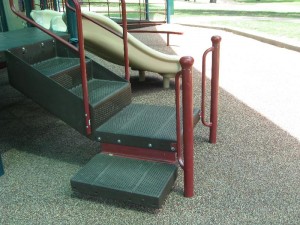
Pool Transfer Walls
1009.4.1 Clear Deck Space. A clear deck space of 60 inches (1525 mm) minimum by 60 inches (1525 mm) minimum with a slope not steeper than 1:48 shall be provided at the base of the transfer wall. Where one grab bar is provided, the clear deck space shall be centered on the grab bar. Where two grab bars are provided, the clear deck space shall be centered on the clearance between the grab bars.
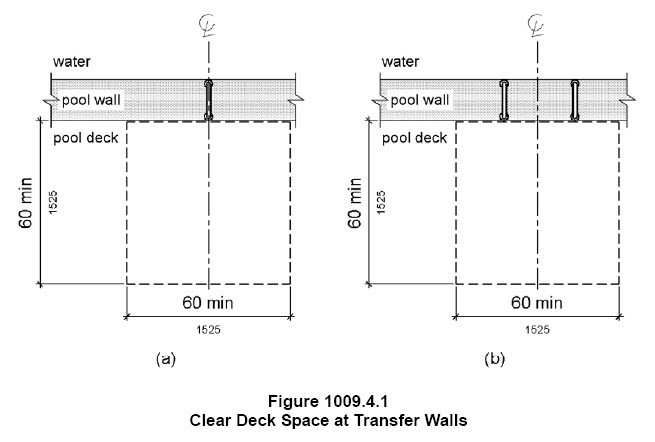
1009.4.3 Wall Depth and Length. The depth of the transfer wall shall be 12 inches (305 mm) minimum and 16 inches (405 mm) maximum. The length of the transfer wall shall be 60 inches (1525 mm) minimum and shall be centered on the clear deck space.
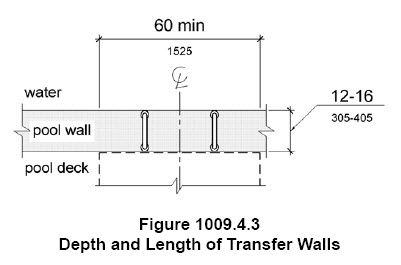
1009.5.2 Transfer Space. A transfer space of 60 inches (1525 mm) minimum by 60 inches (1525 mm) minimum with a slope not steeper than 1:48 shall be provided at the base of the transfer platform surface and shall be centered along a 24 inch (610 mm) minimum side of the transfer platform. The side of the transfer platform serving the transfer space shall be unobstructed.
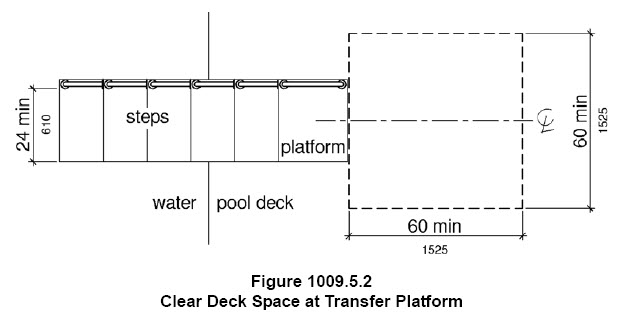
Forward Approach but not centered
The following elements are required to have a forward approach, but do not require it to be centered.
605 Urinals

606 Lavatories and Sinks
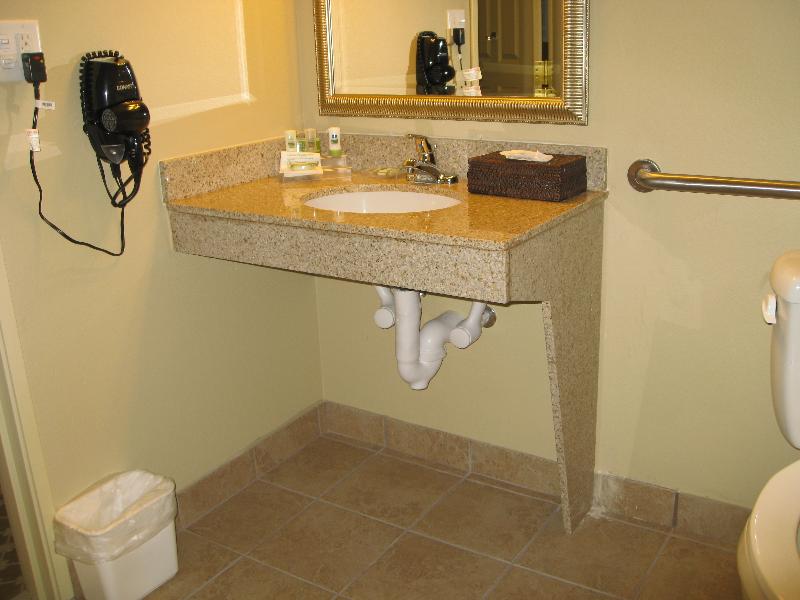
902 Dining and Work Surfaces
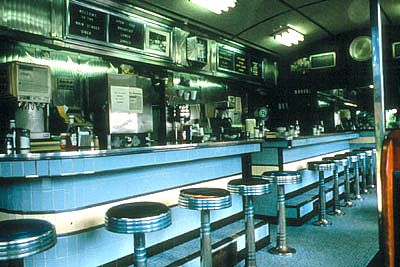
Parallel Approach bu not centered
The following elements are allowed to have a parallel approach, but do not require it to be centered.
704 Telephones
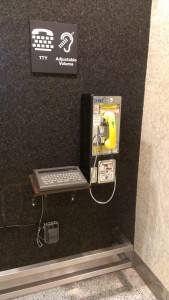
804 Range or cooktop

Photo: The range can have a parallel approach, but the sink requires a forward approach.
904 Sales Counters
If parallel approach is provided, it requires 36″ in width and 36″ in height plus the same depth as the main counter
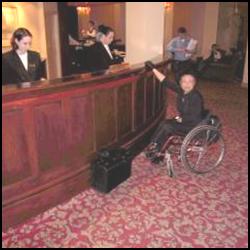
Photo 1: This photo is of a service counter/reception desk at a hotel that did not provide the 36″ wide x 36″ high counter
If forward approach is provided, it requires 30″ in width and 36″ in height, plus the same depth as the main counter and a knee and toe space per 306
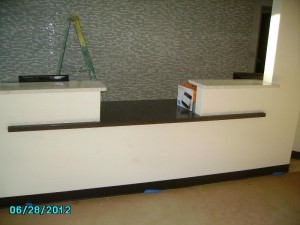
Photo 2: This counter has provided a lower portion that meets the requirements for the parallel approach. (photo provided by Structures and Interiors)
602 Exception at Drinking Fountains for children
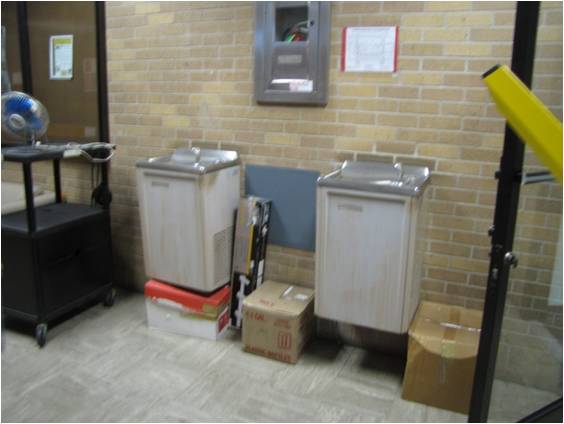
606 Exception at sinks in kitchens without a cooktop or range
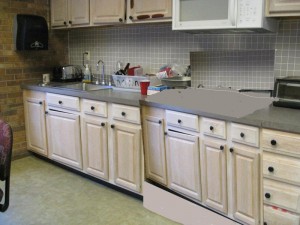
Photo: This kitchen has a built in microwave but NO cooktop, therefore it can take the exception for parallel approach at the sink.
606 Exception at Wet bars
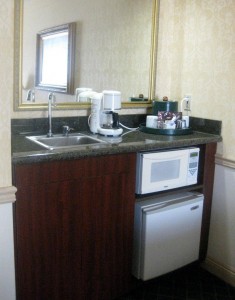
606 Exception at lavatories or sinks for children under 5
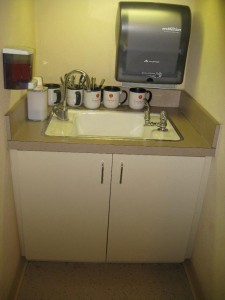
804 Freezers or Refrigerator in kitchens
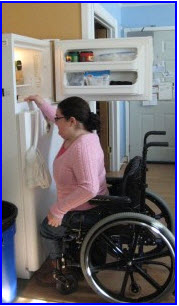
Continuing Education Opportunities
November 2- International Facilities Managers Association Convention in San Antonio, Texas
November 7- provided by SSTL Codes 4 hr ADA seminar in Tulsa OK
If you want to learn more about the new Standards, The ADA Companion Guide explains the 2004 ADAAG Guidelines with commentary and explanations throughout. The 2004 Guidelines were adopted by the DOJ to create the 2010 Standards and by Texas to create the 2012 TAS. This book explains the technical requirements for both.
NOTE: Our offices will be closed October 1 and 2nd and again October 8th and 9th for religious observance.
If you have any questions about these or any other topics, please feel free to contact me anytime.
Marcela Abadi Rhoads, RAS #240
Abadi Accessibility
214. 403.8714
Sunday, September 23rd, 2012
After I sent last month’s newsletter I felt like we all need a break from learning theory and maybe see how it all applies! This newsletter shares with you some interesting violations that I found during inspections this past year.
Inspector’s Corner: Grab bars
The 2010 ADA and 2012 TAS has new requirements for grab bars as they relate to objects mounted above or beneath the grab bar. If a toilet paper dispenser is mounted below the grab bar, there needs to be a 1 1/2″ space between the bottom of the grab bar and the top of the toilet paper dispenser. This is so that a person can hold the grab bar and wrap their hand all the way around the grab bar. In this inspection I noticed that the toilet paper was too close to the grab bar
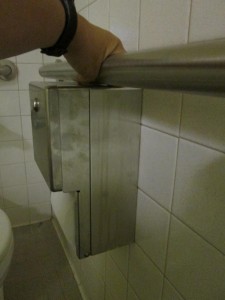
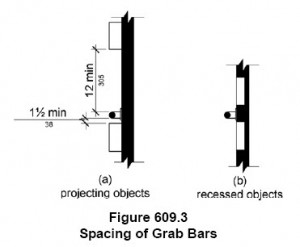
Inspector’s Corner: level changes
An accessible route is required to be stable, firm and slip resistant. It doesn’t necessarily need to be smooth. You are allowed to have uneven surfaces along the route, but you still have to make sure that the changes in level along the route is no higher than 1/4″, and the gaps between the ground surface should not be wider than 1/2″.
Flagstone is allowed to be used, but I inspected a path with flagstone that was not laid properly and some of the stones were higher than 1/4″ than the adjacent surfaces and the grout joints were wider than 1/2″

Inspector’s Corner: Signage
The 2010 ADA and 2012 TAS both have a new requirement for signage. There needs to be an 18″x18″ clear floor space in front of the signage. This allows a person to stand in front of the sign to read it. At one of my inspections I saw a drinking fountain at the clear floor space. Because this is a new rule, this sign was a safe harbor. In other words, the owner will not have to move the drinking fountain out of the way. But in the future, they will need to design the sign without obstructions.
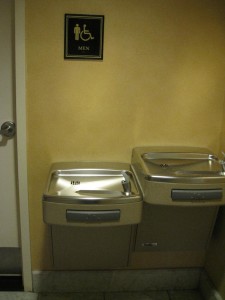

Inspector’s Corner: Just for fun!
We don’t always have to take ourselves so seriously…..
Here are some funny photos my clients send to me just for fun! Enjoy
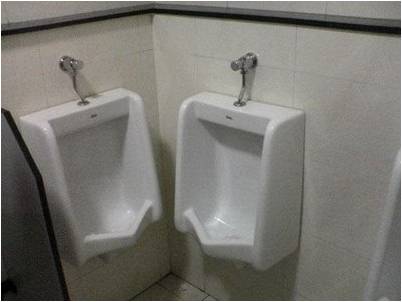
Urinals must have a clear floor space in front
AND IT PROBABLY SHOULDN’T BE SHARED!

Do you think this will work?

Interesting solution!
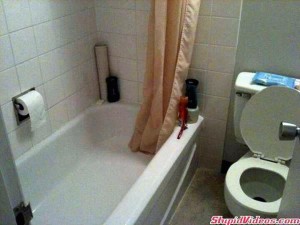
The toilet paper should be located somewhat within reach range. What do you think?
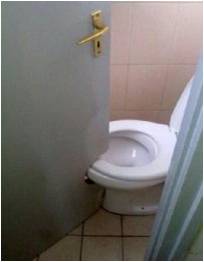
They get an “A” for effort!
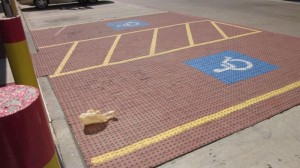
I think this is the parking at “LegoLand” 😉
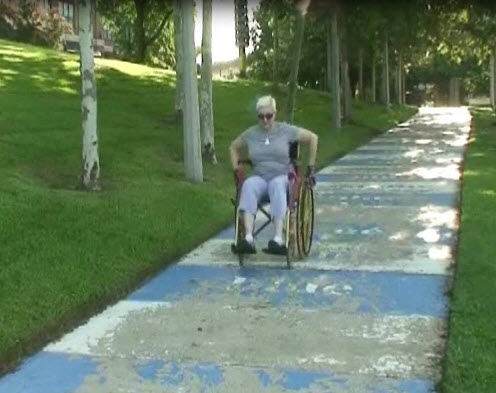
My friend Jeromy Murphy RAS #489 created this video about slopes. It is really well done and I think you will enjoy it.
Continuing Education Opportunities
September 5th- AIA Dallas Procrastinator’s day
September 12th- CSI’s Construct Show at Phoenix Arizona
November 2- International Facilities Managers Association Convention in San Antonio, Texas
If you want to learn more about the new Standards, The ADA Companion Guide explains the 2004 ADAAG Guidelines with commentary and explanations throughout. The 2004 Guidelines were adopted by the DOJ to create the 2010 Standards and by Texas to create the 2012 TAS. This book explains the technical requirements for both.
If you have any questions about these or any other topics, please feel free to contact me anytime.
Marcela Abadi Rhoads, RAS #240
Abadi Accessibility
214. 403.8714
Tuesday, September 11th, 2012
Doug Walter, AIA and I are presenting at Construct12 Convention in Phoenix. As part of our talk we are providing some of our favorite ADA and accessibilty books we have read and recommend. There are also great websites we have found that we also want to make available:
GOVERNMENT AGENCIES
US ACCESS BOARD
EEOC
DEPARTMENT OF JUSTICE
HUD (Housing & Urban Development)
GSA (General Services Administration)
Veterans Administration
BOOKS
Access by Design, by G.A. & Hannah Covington, Van Nostrand Reinhold, 1997.
Accessibility Pocket Book:2009 IBC/ICC ANSI A117.1-2003, by the International Code Council, Inc.
Americans with Disabilities Act and Architectural Barriers Act Accessibility Guidelines, July 23, 2004, by the United States Access Board
The ADA Companion Guide : Understanding the 2004 Americans with Disabilities Act Accessibility Design Guidelines, by Marcela A. Rhoads, 2010
The Disability Studies Reader, by Lennard J. Davis, 2010
Universal Design By Sternfeld and Moisel
Implementing the Americans with Disabilities Act Edited by Jane West
Understanding the Americans with Disabilities Act by Bill D. Goren
SUPPORT ORGANIZATIONS FOR SPECIFIC CONDITIONS
Alzheimer’s Association www.alz.org
Arthritis Foundation www.arthritis.org
American Federation of the Blind www.afb.org
Home Free Home www.homefreehome.org
National Federation for the Blind www.nfb.org
American Lung Association www.lung.org
Brain Injury Association of America www.bia.org
National Down Syndrome Society www.ndss.org
Easter Seals www.easterseals.com
Epilepsy Foundation www.epilepsyfoundation.org
March of Dimes www.marchofdimes.com
Muscular Dystrophy Association www.mda.org
National Association of the Deaf www.nad.org
National Multiple Sclerosis Society www.nationalmssociety.org
WEBSITES
The US Access Board
Texas Department of Licensing and Regulation www.license.state.tx.us
Disability.gov
The National Organization on Disability
The National Council on Disability
National Council on Independent Living (NCIL)
AHEAD: the Association of Higher Education and Disability, www.ahead.org
www.universaldesign.com
OTHER BIBLIOGRAPHIES
“Criplit”Disability Bibliographies, by AHEAD, Association on Higher Education and Disability, http://www.ahead.org/resources/bibliographies
NLS Accessibility:A Selective Bibliography, http://www.loc.gov/nls/reference/bibliographies/accessibility.html
Thursday, August 23rd, 2012
In the 2010 ADA and the 2012 TAS requires that 5% but no less than 1 sink must be accessible. One of the requirements of accessibility at sinks is to have a knee space under the sink. But there is a new exception:
606.2 Clear Floor Space Exception 1: A parallel approach complying with 305 shall be permitted to a kitchen sink in a space where a cook top or conventional range is not provided, and to wet bars.
The Texas Department of Licensing and Regulation issued a bulletin that explains when this exception can be taken and when it cannot. This newsletter will explain it as well.
Break Rooms
Does my sink at my break room have to have a knee space?
It depends (don’t you love that answer?)…..
It depends on whether the break room is a kitchen or not. But it can’t be our definition of a “kitchen”, but the dictionaries definition. When dealing with terms that the ADA and TAS do not define, we are directed by the US Access Board to use the Webster’s definitions:
– Kitchen: A place (as a room) with cooking facilities.
– Kitchenette: A small kitchen or alcove containing cooking facilities.
– Wet Bar: A bar for mixing drinks that contains a sink with running water.
– Cooking Facilities: Fixed or built-in range, cook top, oven, microwave, or convection oven.
-Fixed Appliance: When attached to a cabinet, shelf or other surface or to a gas supply.
-Built -In Appliance: When cabinetry design or location of utilities (i.e.. gas supply or 220V electrical outlets) creates a dedicated shelf or space for the appliance.
So, if a break room has “cooking facilities” within, then it is a kitchen.
If it is a kitchen and has a cook top or a range, then a knee space at the sink will be required.
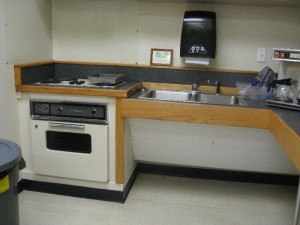
But if the break room has a built in microwave or oven, then it will still be considered a “kitchen” but now the sink can take the exception and have a parallel approach rather than a front approach.

This break room has a microwave on top of the counter. This is not considered a “fixed cooking facility”, therefore this space is not a ‘kitchen” and the sink will require a knee space.
If our space is not a true kitchen based on the definition, then if there is storage located within, it must comply only with Scoping 225 which says that at least one of the storage units must comply with 811 and be within reach range. This is important, because if we truly have a kitchen, there would be many more requirements associated with them. See the next entry for those.
212 and 804 Kitchens, Kitchenettes and Sinks
Based on the definition we discussed earlier, if the space is truly a kitchen, then certain requirements will be listed in the scoping of the ADA and TAS:
- 5% of sinks but no fewer than one must comply with 606
- And they must follow the technical standards of section 804
Section 804 states that kitchens must follow the following requirements:
- Floor clearances must be provided depending on the configuration of the kitchen
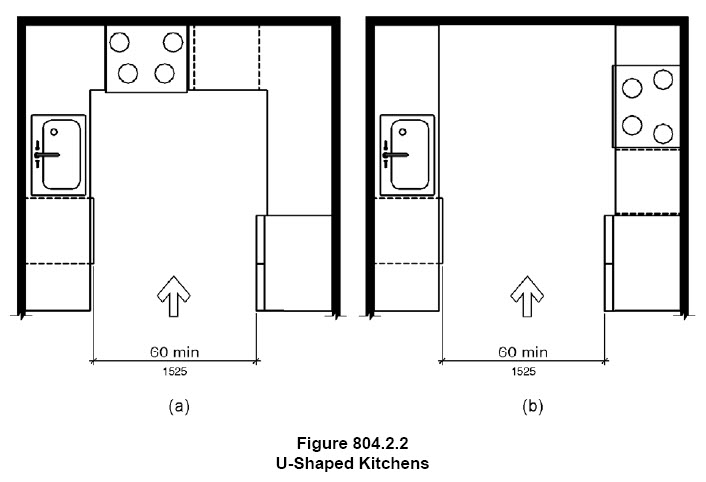
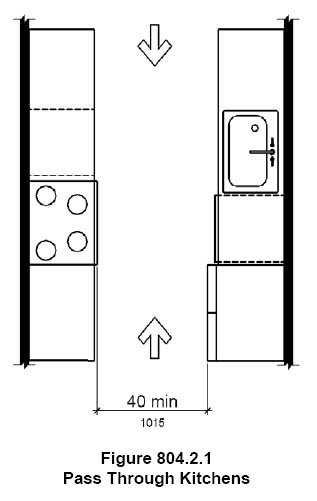
- A work surface in a “residential” kitchen will require an additional knee space not under a sink. To understand about what is considered “residential”, you can read our July edition of our newsletter
- Heights of work surfaces must be 34″ high max above the floor
- Sinks shall comply with 606
- 50% of the shelf space in storage shall comply with 811 (measured in linear feet)
This is an important one! In order for this to be able to be compliant, the shelves must be within reach range. Which means that if a kitchen has upper cabinets and base cabinets, the number of linear feet of shelving must be the same for the non-accessible ones than for the accessible ones. This could be problematic since at the base cabinets there is typically appliance, knee spaces and no shelving.
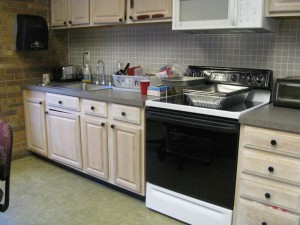
- Appliances in kitchens must be accessible and follow requirements listed in 804.6
Commercial kitchens are exempted from having to comply with these requirements since they are part of a “work area”
Wet Bars and other Sinks
Another location where a knee space at a sink is not required is at wet bars. Wet bars are defined in our first entry, but it is a place where drinks are mixed. They are typically found either at hotels and other transient lodging places or sometimes even at waiting rooms. According to TDLR, a break room is not a wet bar.
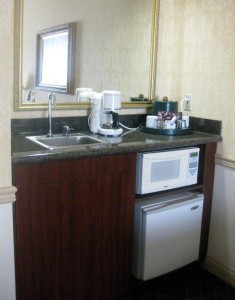
This is a wet bar and does not require a knee space
The other sinks that must follow the scoping of 212 and the technical requirements of 606 are common use sinks such as science labs at a school.
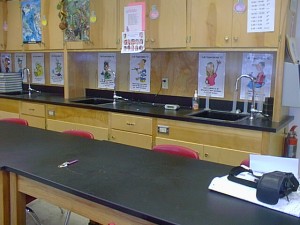
But sinks that are not common use, but are part of a work area and are only used for work related activities are exempted as a “work area”. These are located in teacher workrooms, back of bar at a restaurant, or commercial kitchens.
Continuing Education Opportunities
August 9th- Metrocon12 in Dallas Texas “2012 TAS in interior projects”
September 5th- AIA Dallas Procrastinator’s day
September 12th- CSI’s Construct Show at Phoenix Arizona
November 2- International Facilities Managers Association Convention in San Antonio, Texas
If you want to learn more about the new Standards, The ADA Companion Guide explains the 2004 ADAAG Guidelines with commentary and explanations throughout. The 2004 Guidelines were adopted by the DOJ to create the 2010 Standards and by Texas to create the 2012 TAS. This book explains the technical requirements for both.
If you have any questions about these or any other topics, please feel free to contact me anytime.
Marcela Abadi Rhoads, RAS #240
Abadi Accessibility
214. 403.8714
Monday, August 20th, 2012
The Americans with Disabilities Act became the civil rights law for disabled Americans in 1990. Ever since then, the disabled community has been able to get jobs, enjoy independence and become productive members of our society. The ADA is organized in five “titles”. In this post we will focus on the Title III which requires that places of public accommodation and commercial facilities be made accessible to persons with disabilities. We will also touch on Title I which states that a business cannot discriminate against a person with disabilities when they are hiring or firing. They can’t decide not to hire someone or fire someone based on their disability. In essence the ADA makes sure that persons with disabilities get treated equally. So how does a building owner and landlord comply?
Part of the ADA required that places of public accommodation and commercial facilities be made accessible to persons with disabilities. By this mandate, building owners had to make their buildings, new or existing accessible. This requirement was sometimes more difficult than was first thought. For newly constructed buildings, they had to make sure that their architect and contractor understood the requirements otherwise their building would not be in compliance and there could be a risk of complaints or worse, a law suit. Ultimately it is the building Owner’s responsibility to make sure things comply, therefore hiring architects, interior designer and contractors that understand the rules, is a huge help.
There are different rules for new construction and remodels. The rules for new construction are a bit simpler. Whatever you build must be in compliance. It only gets complicated if the new constructed areas are spaces that are not required to comply. Some examples of areas that do not require accessibility are mechanical rooms, telephone equipment rooms and electrical rooms. These are exempted based on the fact that they are considered “machinery” spaces. Those are spaces that only have equipment inside and only periodically gets monitored by an employee.
Another area of confusion during design and building are employee areas. Employee areas are not necessarily excempted from having to comply. I hear a lot of building owners say “nobody will ever go back there” when they speak of employee areas. They are correct in making the statement because customers may not necessarily be allowed to go to an exclusively employee or staff area. But what it is not clear is that their employees and staff will be going “back there” and using the facility. This is where Title III of the ADA gets intermingled with Title I. Title III recognizes that not every employee will need the facility to be accessible at the time construction is complete and that the business may not have a disabled person working there. Therefore they are not required to provide accessible “work areas” or areas where the work is happening at the time the project is finished. As soon as a disabled person wants to work there, or if (G-d forbid) an employee becomes disabled while working there, accommodations will have to be provided. Thus the work areas are exempted from the Title III of the ADA except for the ability to approach the area, enter the area and exit the area. For example, if there is a stock room or a copy room in an office space, those are considered work areas and only require approach, enter and exit. The elements within the space, such as counters and shelving or even sinks, will not be required to comply.
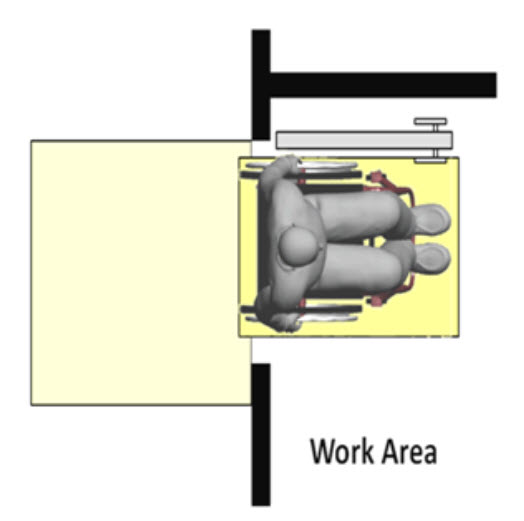
But it is not ALL employee areas. This exemption is only allowed to be taken for work areas. Therefore employee restrooms or employee break rooms are not exempted and must be accessible. The reason is that these spaces are not part of the job description, but rather where they take breaks from work. Private offices that have restrooms inside them, are also exempted for certain elements. The restroom should have the proper clearances, but grab bars, knee space at sinks and knee spaces at sinks will not be required at the onset.
The next type of construction is an alteration. This type of construction is a bit more complicated to decide what is required and what is not. The first thing one has to determine is what area of the building is being remodeled or altered. Does the area contain a primary function of the space? If it does not, such as a restroom or a storage room for example, then only the new elements must comply. So if a new paper towel dispenser in a restroom is getting added, or even if an entire restroom is getting remodeled, only the restroom must comply and nothing else outside the restroom, including the entrance to the restroom. But if the answer is that yes, the area being altered contains a primary function, then the new elements and spaces must comply but in addition to the new elements, existing path of travel from the main entrance of the building must also comply. If the existing path of travel contains restrooms, drinking fountains and public telephones, those also must comply with the ADA Standards. In Texas, the Texas Accessibility Standards added parking to the list. Therefore the parking that serves the altered area must also be in compliance.

There is a new exception to this rule of the path of travel. If the building owner is leasing the space to a tenant and the tenant is the one who is paying for the finish out, then the path of travel elements within the building that leads to the tenant space does not have to be brought up to compliance if they don’t already comply. If the landlord pays for any of the tenant finish out via an allowance or any other financial means, then the same rules apply for the alteration of a primary function and the path of travel elements will have to be brought up to compliance. Also, if the facility and the elements along the path of travel comply, but they comply with the old Standards (1991 ADAAG or 1994 TAS), then those are considered a “safe harbor” and also do not have to be brought up to compliance.
If during the alteration, it is discovered that the upgrade to the elements found along the path of travel would cost more than 20% of the total construction cost, the Department of Justice considers it “disproportionate”. Due to disproportionality, the DOJ allows a postponement to the upgrades. If the upgrades will be postponed, the DOJ requires that certain things be done in a certain priority level. Costs that may be counted as expenditures required to provide an accessible path of travel may include:
1) Costs associated with providing an accessible entrance and an accessible route to the altered area, for example, the cost of widening doorways or installing ramps;
2) Costs associated with making restrooms accessible, such as installing grab bars, enlarging toilet stalls, insulating pipes, or installing accessible faucet controls;
3) Costs associated with providing accessible telephones, such as relocating the telephone to an accessible height, installing amplification devices, or installing a text telephone (TTY); and
4) Costs associated with relocating an inaccessible drinking fountain.
The DOJ has established a priority list of items that are required to comply and what priority to give them. A building owner may not decide to fix the door hardware of interior doors before they fix the main entrance. In choosing which accessible elements to provide, priority should be given to those elements that will provide the greatest access, in the following order:
(1) An accessible entrance;
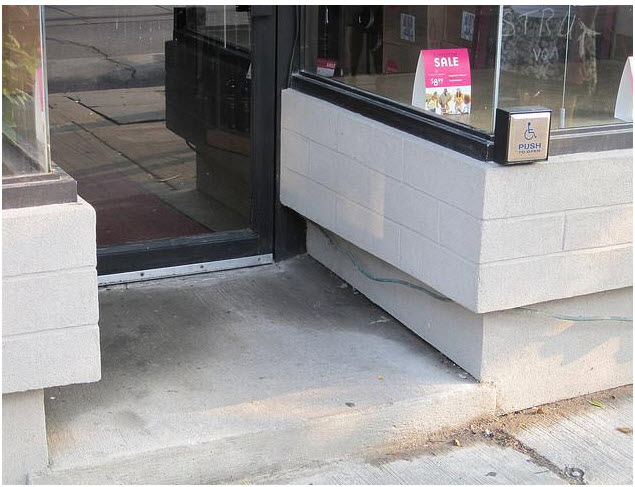
(2) An accessible route to the altered area;
(3) At least one accessible restroom for each sex or a single unisex restroom;
(4) Accessible telephones;
(5) Accessible drinking fountains; and
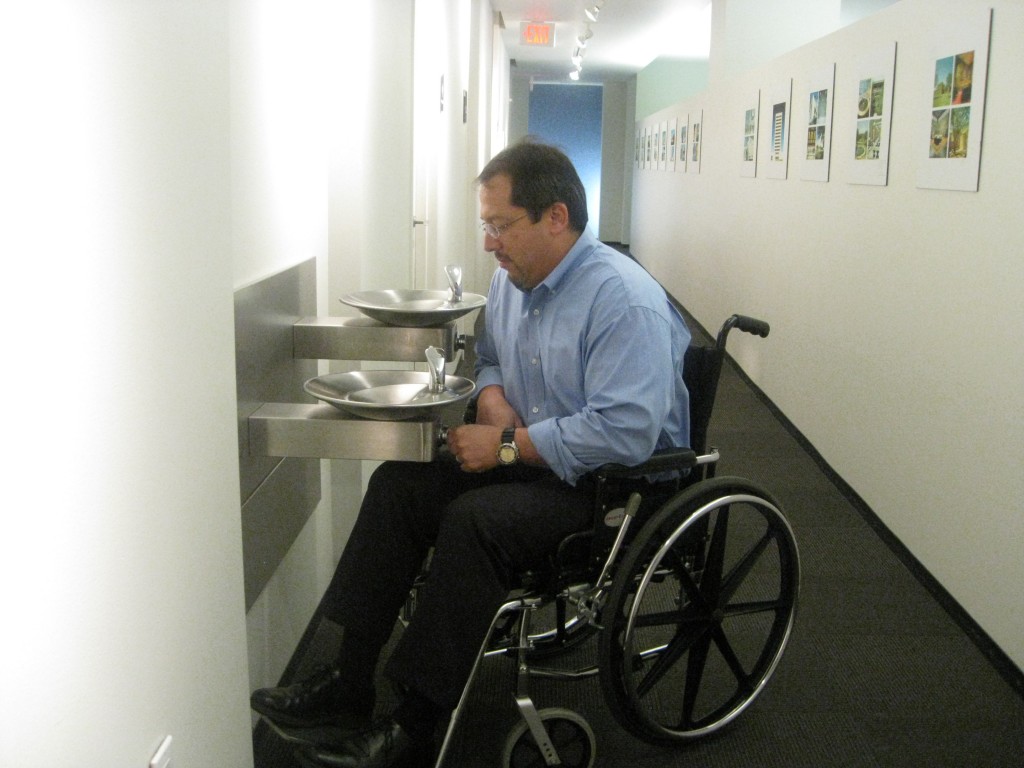
(6) When possible, additional accessible elements such as parking, storage, and alarms.
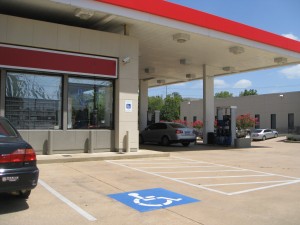
Sometimes the best efforts finds that access cannot be accomplished because existing structural conditions would require removing or altering a load-bearing member that is an essential part of the structural frame or because other existing physical or site constraints prohibit modification. In those cases, speaking to local authorities and the DOJ to get a variance or waiver might be the proper action to take. But even if it is not possible to provide access for wheelchair users, the building owner is still required to make sure other disabilities are accommodated. Accommodations in buildings should be provided for the visually impaired, hearing impaired and people with other mobility issues such as walkers, crutches and braces.
With all the complicated rules and regulations that we might encounter during the design process, it is important to keep in mind the big picture. What was the reason for all this extra effort? Before the ADA was enacted, a person with disabilities was relegated to stay home or in an institution. They depended on others for transportation and for every day tasks. The ADA was enacted to encourage and promote the rehabilitation of persons with disabilities, to eliminate unnecessary architectural barriers for persons with disabilities, to not restrict the ability to engage in gainful occupation and to not restrict the ability to achieve maximum personal independence. As building owners we must keep in mind our customers and how at the end of the day we are opening our doors to a large portion of the population that wasn’t thought of before. And the struggle will continue as Americans age and as more of us become disabled. But these guidelines are universal. When we remove barriers for one group, we are essentially removing barriers for everyone. And the more architectural barriers we remove, the more cultural and social barriers we remove as well.

This post was published in the CREST Publications’s Network Magazine September 2012 edition
Thursday, July 12th, 2012
TDLR issued a new RAS bulletin for projects that are built in Texas. Here is the link . I also wrote my August newsletter that explains it:
In summary, here is the issue:
The following terms are not defined in TAS, therefore, based on 106.3, definitions provided in collegiate dictionaries, and information received from the U.S. Access Board, they shall have the referenced meanings:
– Kitchen: A place (as a room) with cooking facilities.
– Kitchenette: A small kitchen or alcove containing cooking facilities.
– Wet Bar: A bar for mixing drinks that contains a sink with running water.
– Cooking Facilities: Fixed or built-in range, cooktop, oven, microwave, or convection oven.
-Fixed Appliance: When attached to a cabinet, shelf or other surface or to a gas supply.
-Built -In Appliance: When cabinetry design or location of utilities (ie. gas supply or 220V electrical outlets) creates a dedicated shelf or space for the appliance.
For purposes of compliance with 212 and 804, the terms “kitchen” and “kitchenette” shall be used interchangeably.
With Cooking Facilities: A room or space with at least one fixed or built-in cooking facility is considered a kitchen/kitchenette and shall be subject to compliance with 212 and 804. Storage required by 804.5 shall be calculated by linear feet.
Section 212 Kitchens and Kitchennettes:
212.1 General. Where provided, kitchens, kitchenettes, and sinks shall comply with 212.
212.2 Kitchens and Kitchenettes. Kitchens and kitchenettes shall comply with 804.
212.3 Sinks. Where sinks are provided, at least 5 percent, but no fewer than one, of each type provided in each accessible room or space shall comply with 606.
EXCEPTION: Mop or service sinks shall not be required to comply with 212.3.
Section 804 Kitchens
These are the technical guidelines for kitchens in common use spaces, residential dwelling units and transient lodging spaces.
804.5 Storage (in kitchens): At least 50 percent of shelf space in storage facilities shall comply with 811. This is measured in linear feet.
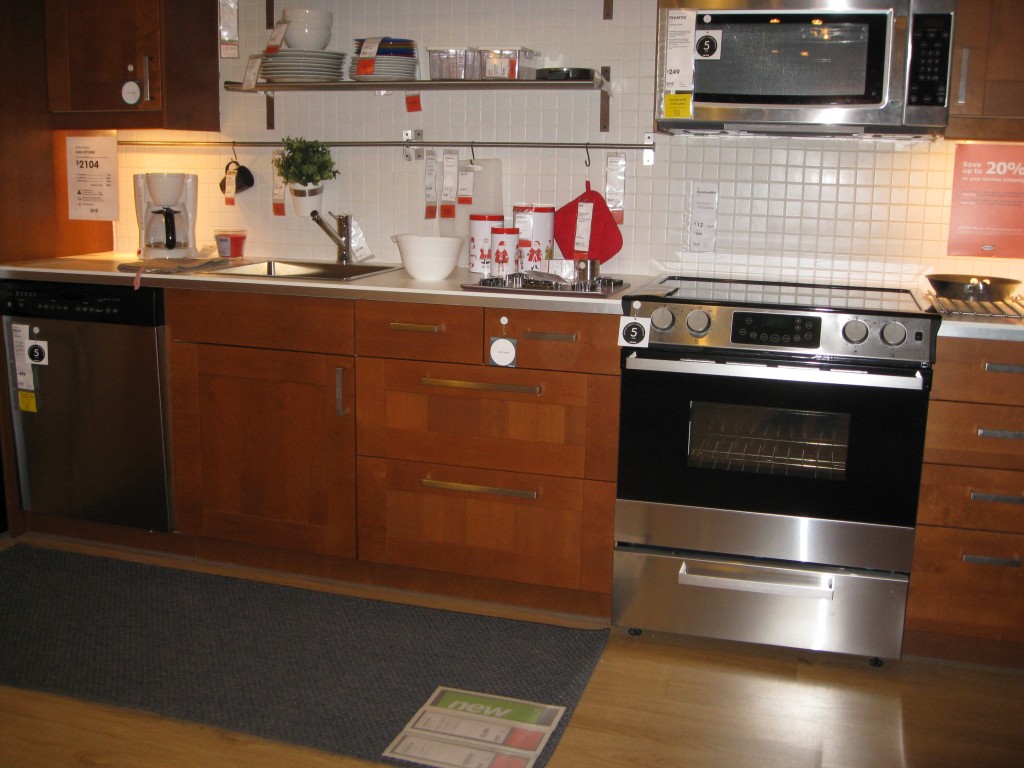
According to TDLR, the photo above would be considered a kitchen with cooking facilities because there is a built in range and built in microwave. Therefore the sink would require a knee space per section 606.2 and be at 34″ high max.
If the same kitchen had a fixed oven only, or a fixed microwave only without a cooktop, then it would still be a kitchen but now the sink would NOT require a knee space.
Without Cooking Facilities: A room or space without a fixed or built-in cooking facility shall be subject to compliance with all applicable provisions of TAS based on the elements provided. 606.2, Exception 1 shall NOT apply to sinks provided in spaces without cooking facilities unless it is a wet bar since this exception is applicable only to kitchen sinks. Storage provided shall comply with 225 and 811.
Section 606 Sinks and Lavatories
606.2 Clear Floor Space. A clear floor space complying with 305, positioned for a forward approach,
and knee and toe clearance complying with 306 shall be provided.
Exceptions:
1. A parallel approach complying with 305 shall be permitted to a kitchen sink in a space where a
cook top or conventional range is not provided and to wet bars.
3. In residential dwelling units, cabinetry shall be permitted under lavatories and kitchen sinks
provided that all of the following conditions are met:
(a) the cabinetry can be removed without removal or replacement of the fixture;
(b) the finish floor extends under the cabinetry; and
(c) the walls behind and surrounding the cabinetry are finished.
4. A knee clearance of 24 inches (610 mm) minimum above the finish floor or ground shall be
permitted at lavatories and sinks used primarily by children 6 through 12 years where the rim or
counter surface is 31 inches (785 mm) maximum above the finish floor or ground.
5. A parallel approach complying with 305 shall be permitted to lavatories and sinks used primarily
by children 5 years and younger.
6. The dip of the overflow shall not be considered in determining knee and toe clearances.
Section 225 Storage
225.2 Storage. Where storage is provided in accessible spaces, at least one of each type shall comply with 811.
811 Storage
This section describes the techincal requirements for storage in common use accessible spaces including common use, residential and transient lodging. (but they are different than in kitchens which should follow 804.5)
811.1 General. Storage shall comply with 811.
811.2 Clear Floor or Ground Space. A clear floor or ground space complying with 305 shall be
provided.
811.3 Height. Storage elements shall comply with at least one of the reach ranges specified in 308.
811.4 Operable Parts. Operable parts shall comply with 309.

The photo of the sink above shows a sink that is not located at a kitchen as defined by TDLR since there is no “fixed” cooking facility. We see the microwave but it is not fixed. Therefore a knee space is also required at this location.
Wet Bars: A bar used for purposes other than drink preparation is not considered a wet bar.
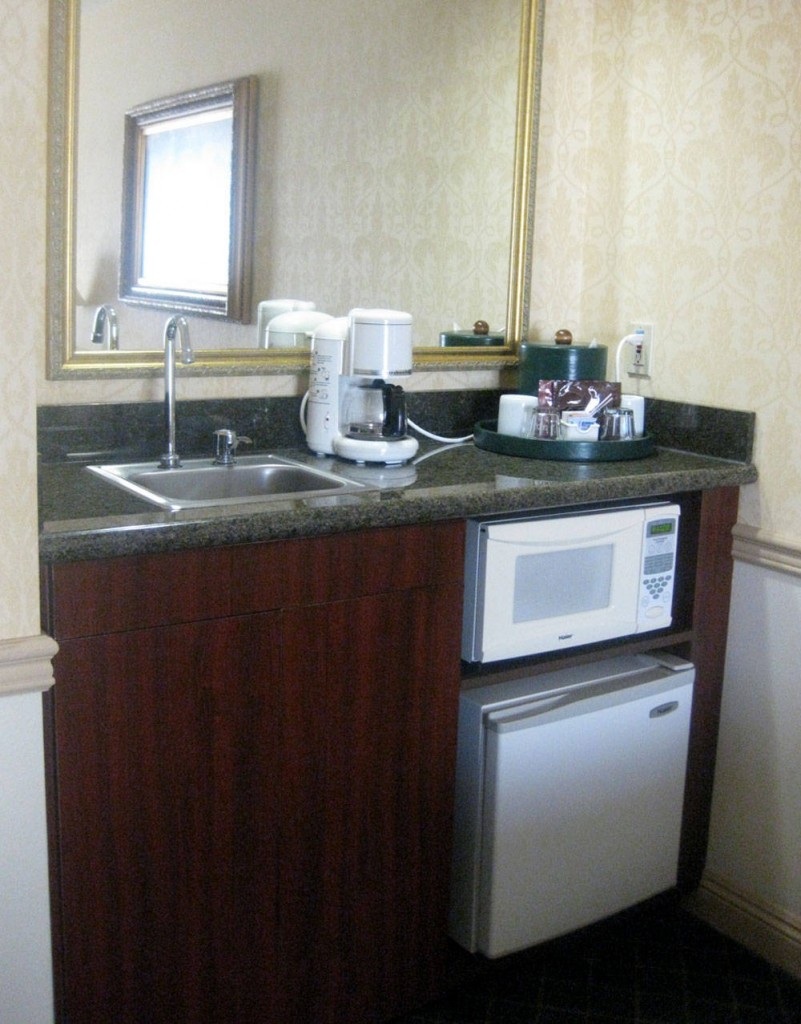
Summary: Kitchens, Kitchenettes, and Comparable Spaces. This table explains when and how many kitchens are required to comply.
Basically, kitchens and ktichennettes in common spaces, must comply with sections 212 and 804 of the 2012 TAS (as well as the 2010 ADA).
Kitchens at residential facilities must comply with sections 233 and 809
Kitchens at Transient lodging must comply with 224 and 806
Kitchens at work areas do not have to comply. These are commercial kitchens or kitchens used for work purposes.
Some kitchens require a separate work surface with a knee space but only at residential and transient lodging places.
Storage not in a kitchen (such as a break room without a fixed cooking facility) will have to comply with 811 and only one of each kind will have to comply.
Storage in kitchens at residential and transient lodging do have to comply with the 50% rule.
For facilities without cooking facilities within and in common use spaces, residential dwelling units and transient lodging, are not considered kitchens. Therefore if they have a sink they must comply with the requirements for sinks listed in 606.2 and are not subject to Exception No. 1 unless it is a wet bar. They also would not be subject to the storage requirement since they are not kitchens. Break rooms are good examples of such facilities. They are not kitchens because they don’t have a built in cooking facility, but must comply with the requirements for sinks.
Sunday, July 1st, 2012
AIA Knowlege Community Webinar was presented on March 2012
http://youtu.be/adGKm1yVKUE?hd=1






 Abadi
Abadi 

























































